Emotional Support Strategies for Osteosarcoma Patients: A Study
VerifiedAdded on 2022/09/25
|10
|2684
|26
Essay
AI Summary
This essay examines the critical role of emotional support for patients grappling with chronic illnesses, specifically focusing on individuals with osteosarcoma who have undergone above-knee amputation. The paper delves into various aspects of patient care, including the challenges of adapting to new lifestyles and the emotional toll of chronic conditions, such as stress, depression, and trauma. The core themes discussed encompass effective verbal and non-verbal communication strategies between healthcare providers, patients, and families; the importance of informed discussions using appropriate language; the crucial role of family and caregiver support; and the significance of multidisciplinary support teams in fostering positive patient outcomes. The essay emphasizes the need for empathy, patient-centered communication, and collaborative efforts to improve the quality of life for chronically ill patients by addressing their emotional and psychosocial needs.
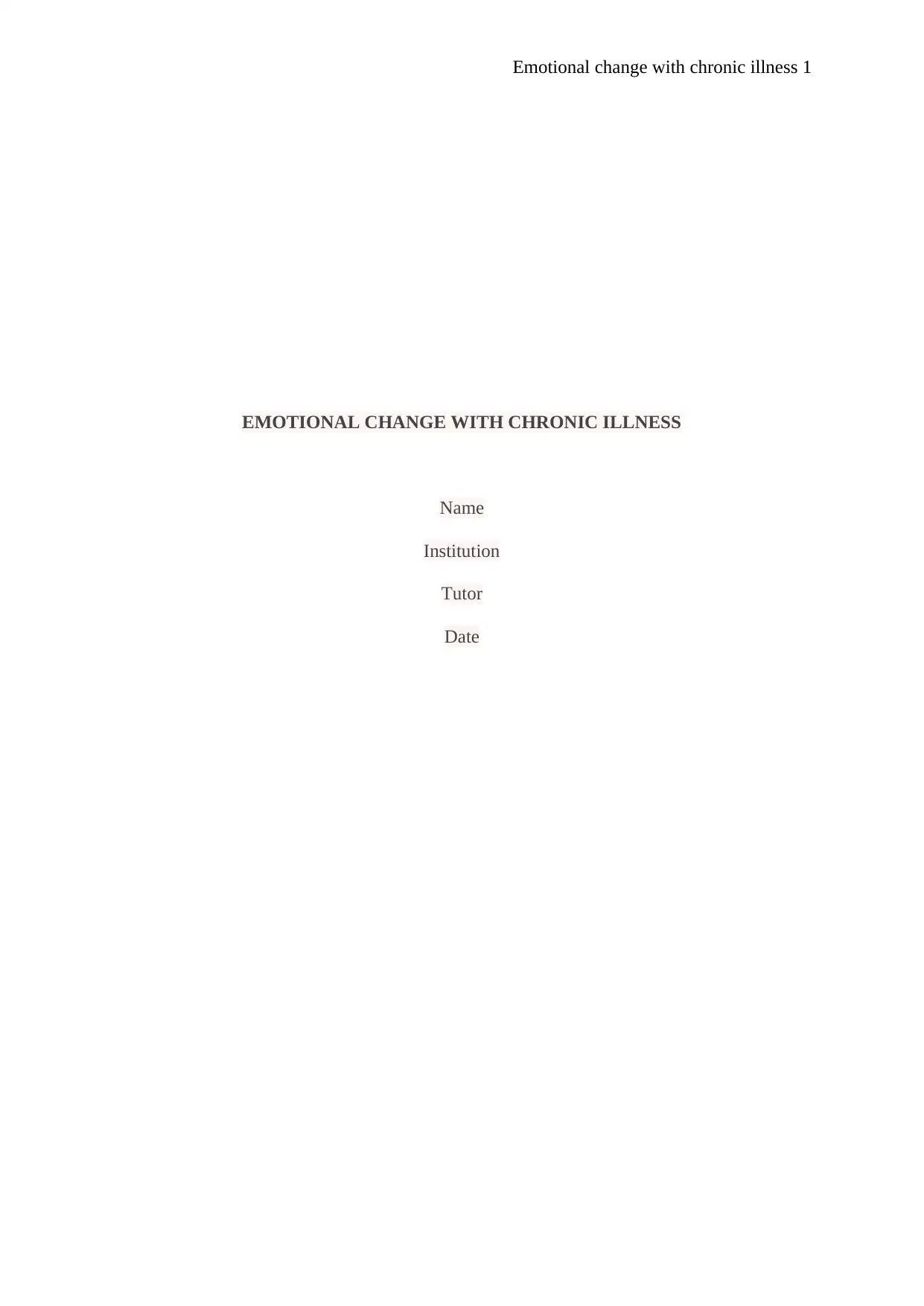
Emotional change with chronic illness 1
EMOTIONAL CHANGE WITH CHRONIC ILLNESS
Name
Institution
Tutor
Date
EMOTIONAL CHANGE WITH CHRONIC ILLNESS
Name
Institution
Tutor
Date
Paraphrase This Document
Need a fresh take? Get an instant paraphrase of this document with our AI Paraphraser
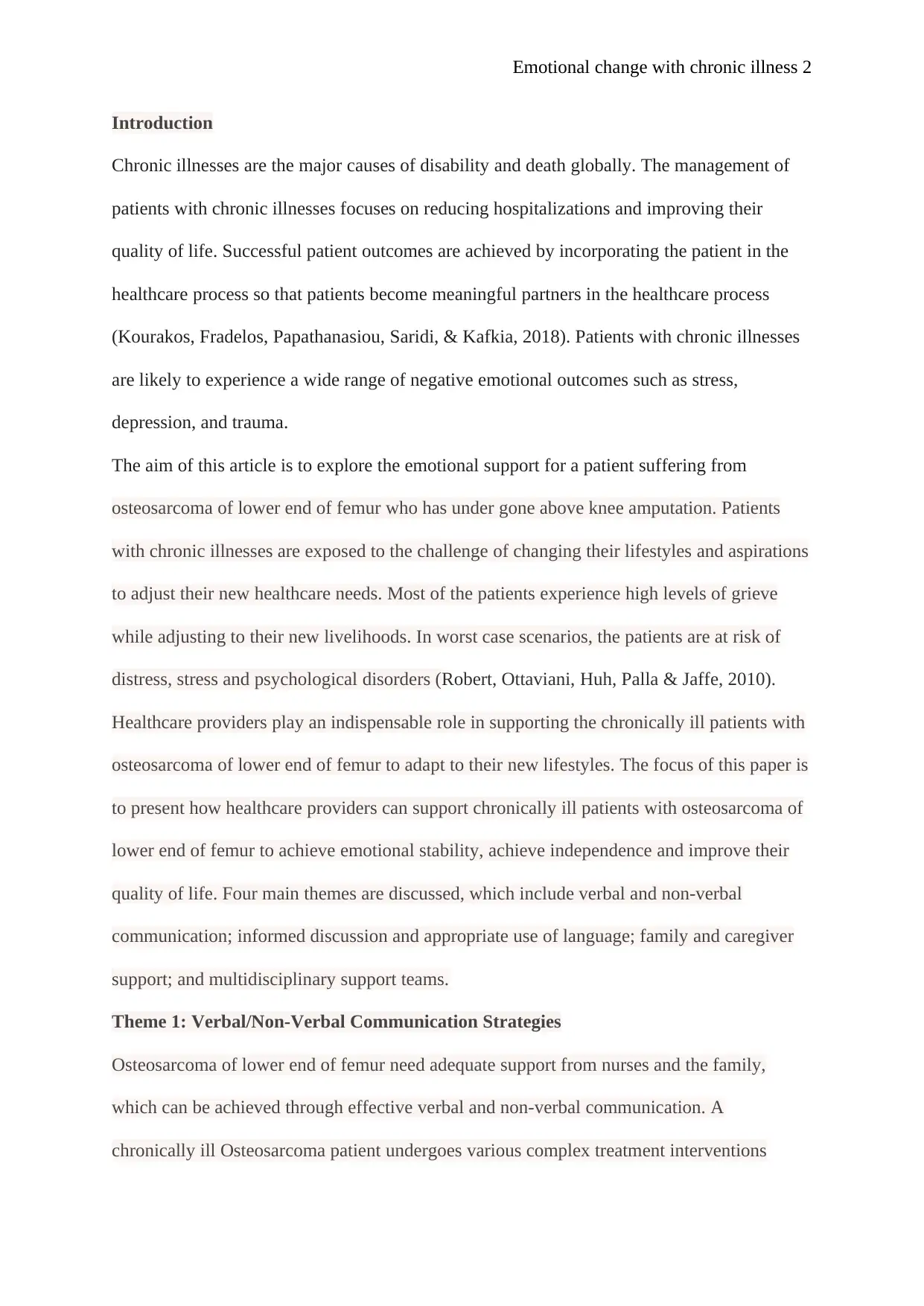
Emotional change with chronic illness 2
Introduction
Chronic illnesses are the major causes of disability and death globally. The management of
patients with chronic illnesses focuses on reducing hospitalizations and improving their
quality of life. Successful patient outcomes are achieved by incorporating the patient in the
healthcare process so that patients become meaningful partners in the healthcare process
(Kourakos, Fradelos, Papathanasiou, Saridi, & Kafkia, 2018). Patients with chronic illnesses
are likely to experience a wide range of negative emotional outcomes such as stress,
depression, and trauma.
The aim of this article is to explore the emotional support for a patient suffering from
osteosarcoma of lower end of femur who has under gone above knee amputation. Patients
with chronic illnesses are exposed to the challenge of changing their lifestyles and aspirations
to adjust their new healthcare needs. Most of the patients experience high levels of grieve
while adjusting to their new livelihoods. In worst case scenarios, the patients are at risk of
distress, stress and psychological disorders (Robert, Ottaviani, Huh, Palla & Jaffe, 2010).
Healthcare providers play an indispensable role in supporting the chronically ill patients with
osteosarcoma of lower end of femur to adapt to their new lifestyles. The focus of this paper is
to present how healthcare providers can support chronically ill patients with osteosarcoma of
lower end of femur to achieve emotional stability, achieve independence and improve their
quality of life. Four main themes are discussed, which include verbal and non-verbal
communication; informed discussion and appropriate use of language; family and caregiver
support; and multidisciplinary support teams.
Theme 1: Verbal/Non-Verbal Communication Strategies
Osteosarcoma of lower end of femur need adequate support from nurses and the family,
which can be achieved through effective verbal and non-verbal communication. A
chronically ill Osteosarcoma patient undergoes various complex treatment interventions
Introduction
Chronic illnesses are the major causes of disability and death globally. The management of
patients with chronic illnesses focuses on reducing hospitalizations and improving their
quality of life. Successful patient outcomes are achieved by incorporating the patient in the
healthcare process so that patients become meaningful partners in the healthcare process
(Kourakos, Fradelos, Papathanasiou, Saridi, & Kafkia, 2018). Patients with chronic illnesses
are likely to experience a wide range of negative emotional outcomes such as stress,
depression, and trauma.
The aim of this article is to explore the emotional support for a patient suffering from
osteosarcoma of lower end of femur who has under gone above knee amputation. Patients
with chronic illnesses are exposed to the challenge of changing their lifestyles and aspirations
to adjust their new healthcare needs. Most of the patients experience high levels of grieve
while adjusting to their new livelihoods. In worst case scenarios, the patients are at risk of
distress, stress and psychological disorders (Robert, Ottaviani, Huh, Palla & Jaffe, 2010).
Healthcare providers play an indispensable role in supporting the chronically ill patients with
osteosarcoma of lower end of femur to adapt to their new lifestyles. The focus of this paper is
to present how healthcare providers can support chronically ill patients with osteosarcoma of
lower end of femur to achieve emotional stability, achieve independence and improve their
quality of life. Four main themes are discussed, which include verbal and non-verbal
communication; informed discussion and appropriate use of language; family and caregiver
support; and multidisciplinary support teams.
Theme 1: Verbal/Non-Verbal Communication Strategies
Osteosarcoma of lower end of femur need adequate support from nurses and the family,
which can be achieved through effective verbal and non-verbal communication. A
chronically ill Osteosarcoma patient undergoes various complex treatment interventions
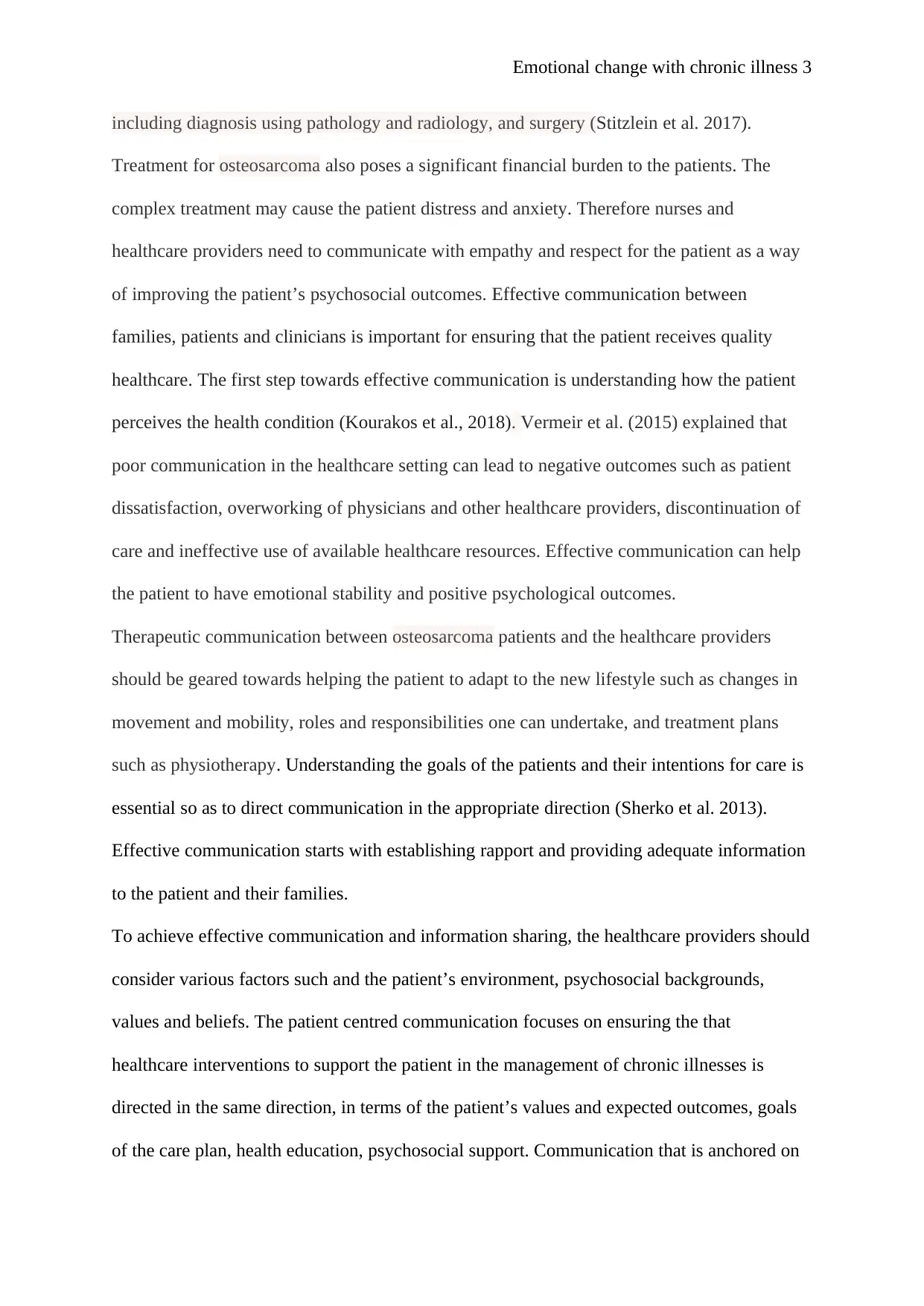
Emotional change with chronic illness 3
including diagnosis using pathology and radiology, and surgery (Stitzlein et al. 2017).
Treatment for osteosarcoma also poses a significant financial burden to the patients. The
complex treatment may cause the patient distress and anxiety. Therefore nurses and
healthcare providers need to communicate with empathy and respect for the patient as a way
of improving the patient’s psychosocial outcomes. Effective communication between
families, patients and clinicians is important for ensuring that the patient receives quality
healthcare. The first step towards effective communication is understanding how the patient
perceives the health condition (Kourakos et al., 2018). Vermeir et al. (2015) explained that
poor communication in the healthcare setting can lead to negative outcomes such as patient
dissatisfaction, overworking of physicians and other healthcare providers, discontinuation of
care and ineffective use of available healthcare resources. Effective communication can help
the patient to have emotional stability and positive psychological outcomes.
Therapeutic communication between osteosarcoma patients and the healthcare providers
should be geared towards helping the patient to adapt to the new lifestyle such as changes in
movement and mobility, roles and responsibilities one can undertake, and treatment plans
such as physiotherapy. Understanding the goals of the patients and their intentions for care is
essential so as to direct communication in the appropriate direction (Sherko et al. 2013).
Effective communication starts with establishing rapport and providing adequate information
to the patient and their families.
To achieve effective communication and information sharing, the healthcare providers should
consider various factors such and the patient’s environment, psychosocial backgrounds,
values and beliefs. The patient centred communication focuses on ensuring the that
healthcare interventions to support the patient in the management of chronic illnesses is
directed in the same direction, in terms of the patient’s values and expected outcomes, goals
of the care plan, health education, psychosocial support. Communication that is anchored on
including diagnosis using pathology and radiology, and surgery (Stitzlein et al. 2017).
Treatment for osteosarcoma also poses a significant financial burden to the patients. The
complex treatment may cause the patient distress and anxiety. Therefore nurses and
healthcare providers need to communicate with empathy and respect for the patient as a way
of improving the patient’s psychosocial outcomes. Effective communication between
families, patients and clinicians is important for ensuring that the patient receives quality
healthcare. The first step towards effective communication is understanding how the patient
perceives the health condition (Kourakos et al., 2018). Vermeir et al. (2015) explained that
poor communication in the healthcare setting can lead to negative outcomes such as patient
dissatisfaction, overworking of physicians and other healthcare providers, discontinuation of
care and ineffective use of available healthcare resources. Effective communication can help
the patient to have emotional stability and positive psychological outcomes.
Therapeutic communication between osteosarcoma patients and the healthcare providers
should be geared towards helping the patient to adapt to the new lifestyle such as changes in
movement and mobility, roles and responsibilities one can undertake, and treatment plans
such as physiotherapy. Understanding the goals of the patients and their intentions for care is
essential so as to direct communication in the appropriate direction (Sherko et al. 2013).
Effective communication starts with establishing rapport and providing adequate information
to the patient and their families.
To achieve effective communication and information sharing, the healthcare providers should
consider various factors such and the patient’s environment, psychosocial backgrounds,
values and beliefs. The patient centred communication focuses on ensuring the that
healthcare interventions to support the patient in the management of chronic illnesses is
directed in the same direction, in terms of the patient’s values and expected outcomes, goals
of the care plan, health education, psychosocial support. Communication that is anchored on
⊘ This is a preview!⊘
Do you want full access?
Subscribe today to unlock all pages.

Trusted by 1+ million students worldwide
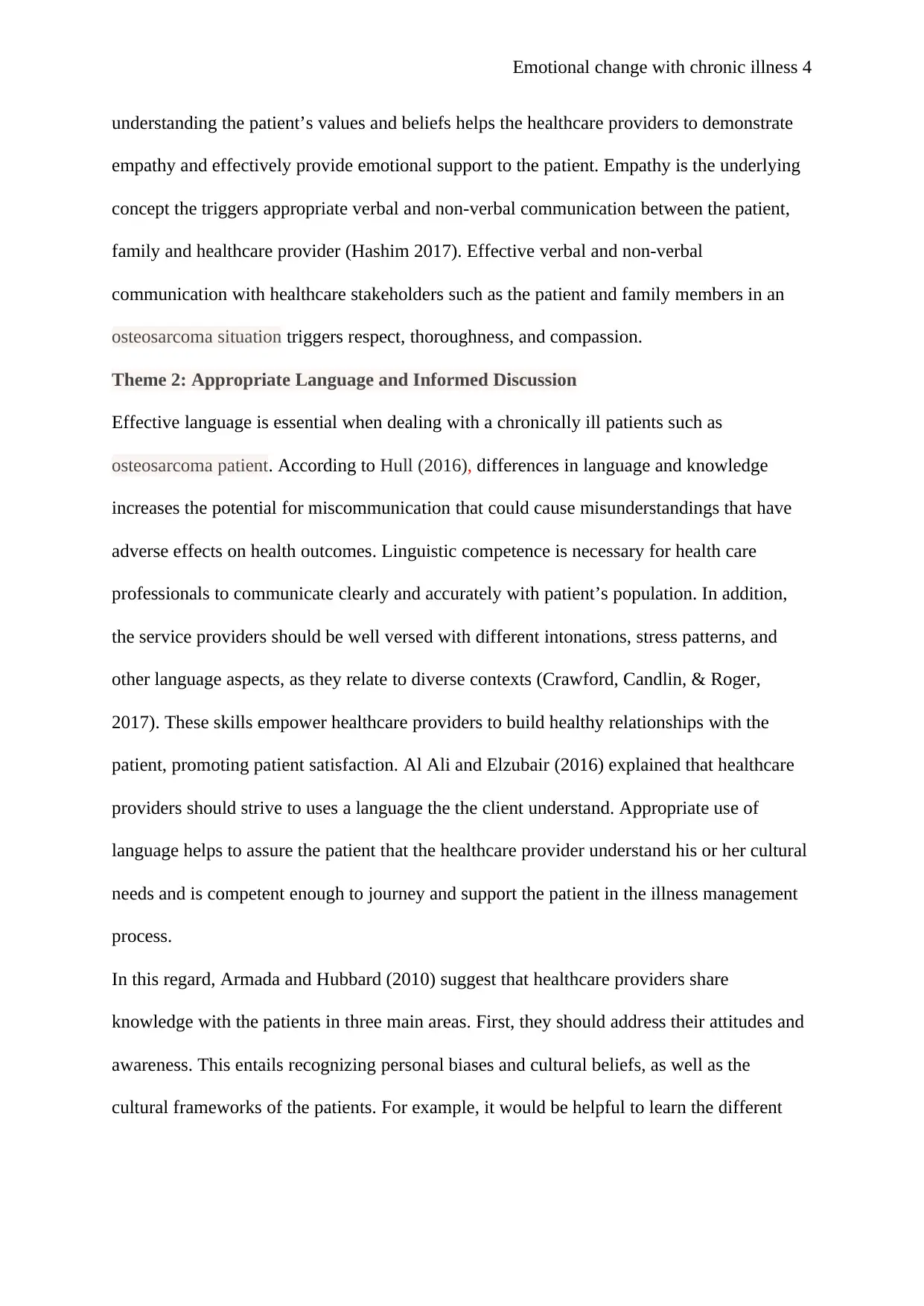
Emotional change with chronic illness 4
understanding the patient’s values and beliefs helps the healthcare providers to demonstrate
empathy and effectively provide emotional support to the patient. Empathy is the underlying
concept the triggers appropriate verbal and non-verbal communication between the patient,
family and healthcare provider (Hashim 2017). Effective verbal and non-verbal
communication with healthcare stakeholders such as the patient and family members in an
osteosarcoma situation triggers respect, thoroughness, and compassion.
Theme 2: Appropriate Language and Informed Discussion
Effective language is essential when dealing with a chronically ill patients such as
osteosarcoma patient. According to Hull (2016), differences in language and knowledge
increases the potential for miscommunication that could cause misunderstandings that have
adverse effects on health outcomes. Linguistic competence is necessary for health care
professionals to communicate clearly and accurately with patient’s population. In addition,
the service providers should be well versed with different intonations, stress patterns, and
other language aspects, as they relate to diverse contexts (Crawford, Candlin, & Roger,
2017). These skills empower healthcare providers to build healthy relationships with the
patient, promoting patient satisfaction. Al Ali and Elzubair (2016) explained that healthcare
providers should strive to uses a language the the client understand. Appropriate use of
language helps to assure the patient that the healthcare provider understand his or her cultural
needs and is competent enough to journey and support the patient in the illness management
process.
In this regard, Armada and Hubbard (2010) suggest that healthcare providers share
knowledge with the patients in three main areas. First, they should address their attitudes and
awareness. This entails recognizing personal biases and cultural beliefs, as well as the
cultural frameworks of the patients. For example, it would be helpful to learn the different
understanding the patient’s values and beliefs helps the healthcare providers to demonstrate
empathy and effectively provide emotional support to the patient. Empathy is the underlying
concept the triggers appropriate verbal and non-verbal communication between the patient,
family and healthcare provider (Hashim 2017). Effective verbal and non-verbal
communication with healthcare stakeholders such as the patient and family members in an
osteosarcoma situation triggers respect, thoroughness, and compassion.
Theme 2: Appropriate Language and Informed Discussion
Effective language is essential when dealing with a chronically ill patients such as
osteosarcoma patient. According to Hull (2016), differences in language and knowledge
increases the potential for miscommunication that could cause misunderstandings that have
adverse effects on health outcomes. Linguistic competence is necessary for health care
professionals to communicate clearly and accurately with patient’s population. In addition,
the service providers should be well versed with different intonations, stress patterns, and
other language aspects, as they relate to diverse contexts (Crawford, Candlin, & Roger,
2017). These skills empower healthcare providers to build healthy relationships with the
patient, promoting patient satisfaction. Al Ali and Elzubair (2016) explained that healthcare
providers should strive to uses a language the the client understand. Appropriate use of
language helps to assure the patient that the healthcare provider understand his or her cultural
needs and is competent enough to journey and support the patient in the illness management
process.
In this regard, Armada and Hubbard (2010) suggest that healthcare providers share
knowledge with the patients in three main areas. First, they should address their attitudes and
awareness. This entails recognizing personal biases and cultural beliefs, as well as the
cultural frameworks of the patients. For example, it would be helpful to learn the different
Paraphrase This Document
Need a fresh take? Get an instant paraphrase of this document with our AI Paraphraser
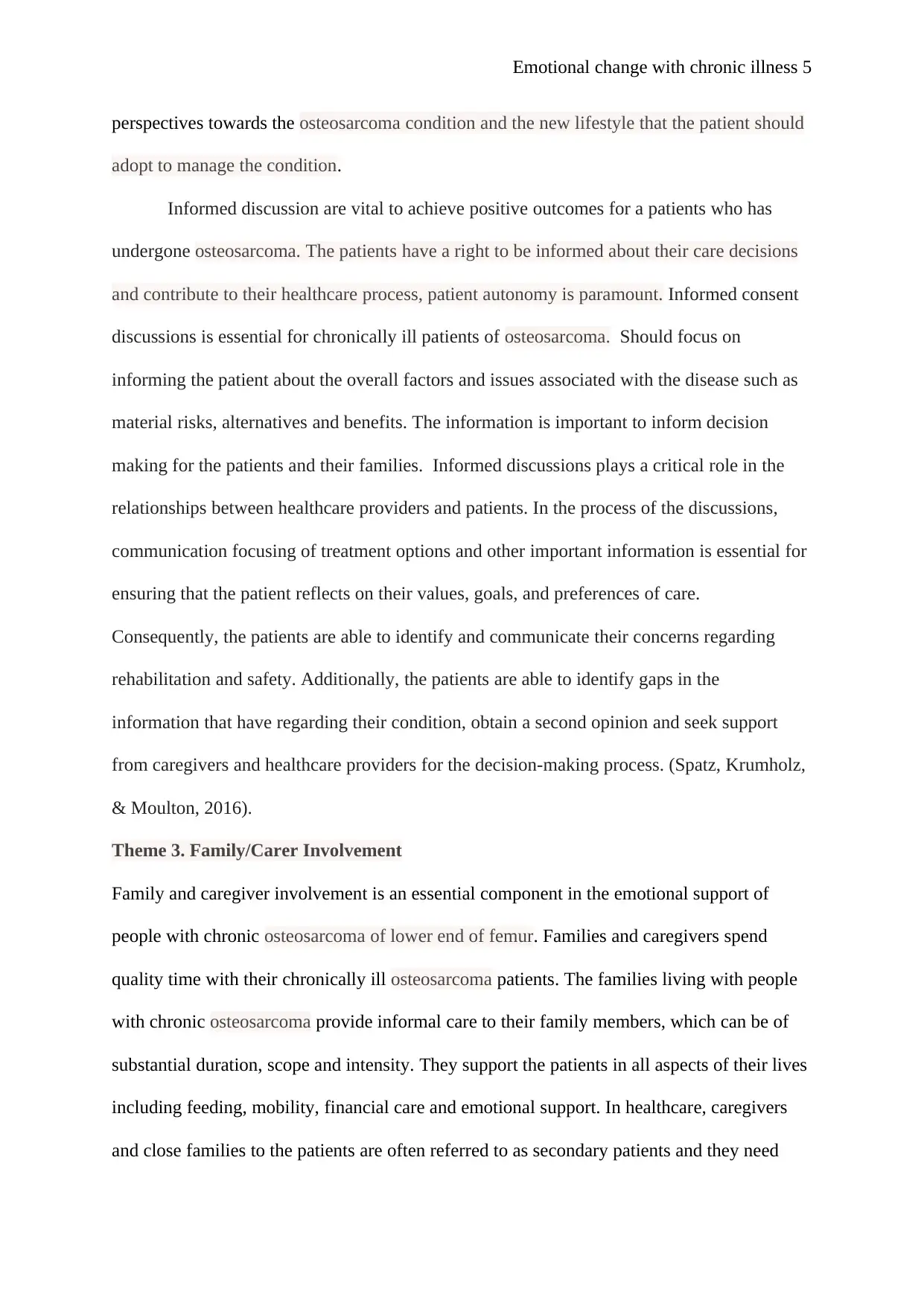
Emotional change with chronic illness 5
perspectives towards the osteosarcoma condition and the new lifestyle that the patient should
adopt to manage the condition.
Informed discussion are vital to achieve positive outcomes for a patients who has
undergone osteosarcoma. The patients have a right to be informed about their care decisions
and contribute to their healthcare process, patient autonomy is paramount. Informed consent
discussions is essential for chronically ill patients of osteosarcoma. Should focus on
informing the patient about the overall factors and issues associated with the disease such as
material risks, alternatives and benefits. The information is important to inform decision
making for the patients and their families. Informed discussions plays a critical role in the
relationships between healthcare providers and patients. In the process of the discussions,
communication focusing of treatment options and other important information is essential for
ensuring that the patient reflects on their values, goals, and preferences of care.
Consequently, the patients are able to identify and communicate their concerns regarding
rehabilitation and safety. Additionally, the patients are able to identify gaps in the
information that have regarding their condition, obtain a second opinion and seek support
from caregivers and healthcare providers for the decision-making process. (Spatz, Krumholz,
& Moulton, 2016).
Theme 3. Family/Carer Involvement
Family and caregiver involvement is an essential component in the emotional support of
people with chronic osteosarcoma of lower end of femur. Families and caregivers spend
quality time with their chronically ill osteosarcoma patients. The families living with people
with chronic osteosarcoma provide informal care to their family members, which can be of
substantial duration, scope and intensity. They support the patients in all aspects of their lives
including feeding, mobility, financial care and emotional support. In healthcare, caregivers
and close families to the patients are often referred to as secondary patients and they need
perspectives towards the osteosarcoma condition and the new lifestyle that the patient should
adopt to manage the condition.
Informed discussion are vital to achieve positive outcomes for a patients who has
undergone osteosarcoma. The patients have a right to be informed about their care decisions
and contribute to their healthcare process, patient autonomy is paramount. Informed consent
discussions is essential for chronically ill patients of osteosarcoma. Should focus on
informing the patient about the overall factors and issues associated with the disease such as
material risks, alternatives and benefits. The information is important to inform decision
making for the patients and their families. Informed discussions plays a critical role in the
relationships between healthcare providers and patients. In the process of the discussions,
communication focusing of treatment options and other important information is essential for
ensuring that the patient reflects on their values, goals, and preferences of care.
Consequently, the patients are able to identify and communicate their concerns regarding
rehabilitation and safety. Additionally, the patients are able to identify gaps in the
information that have regarding their condition, obtain a second opinion and seek support
from caregivers and healthcare providers for the decision-making process. (Spatz, Krumholz,
& Moulton, 2016).
Theme 3. Family/Carer Involvement
Family and caregiver involvement is an essential component in the emotional support of
people with chronic osteosarcoma of lower end of femur. Families and caregivers spend
quality time with their chronically ill osteosarcoma patients. The families living with people
with chronic osteosarcoma provide informal care to their family members, which can be of
substantial duration, scope and intensity. They support the patients in all aspects of their lives
including feeding, mobility, financial care and emotional support. In healthcare, caregivers
and close families to the patients are often referred to as secondary patients and they need
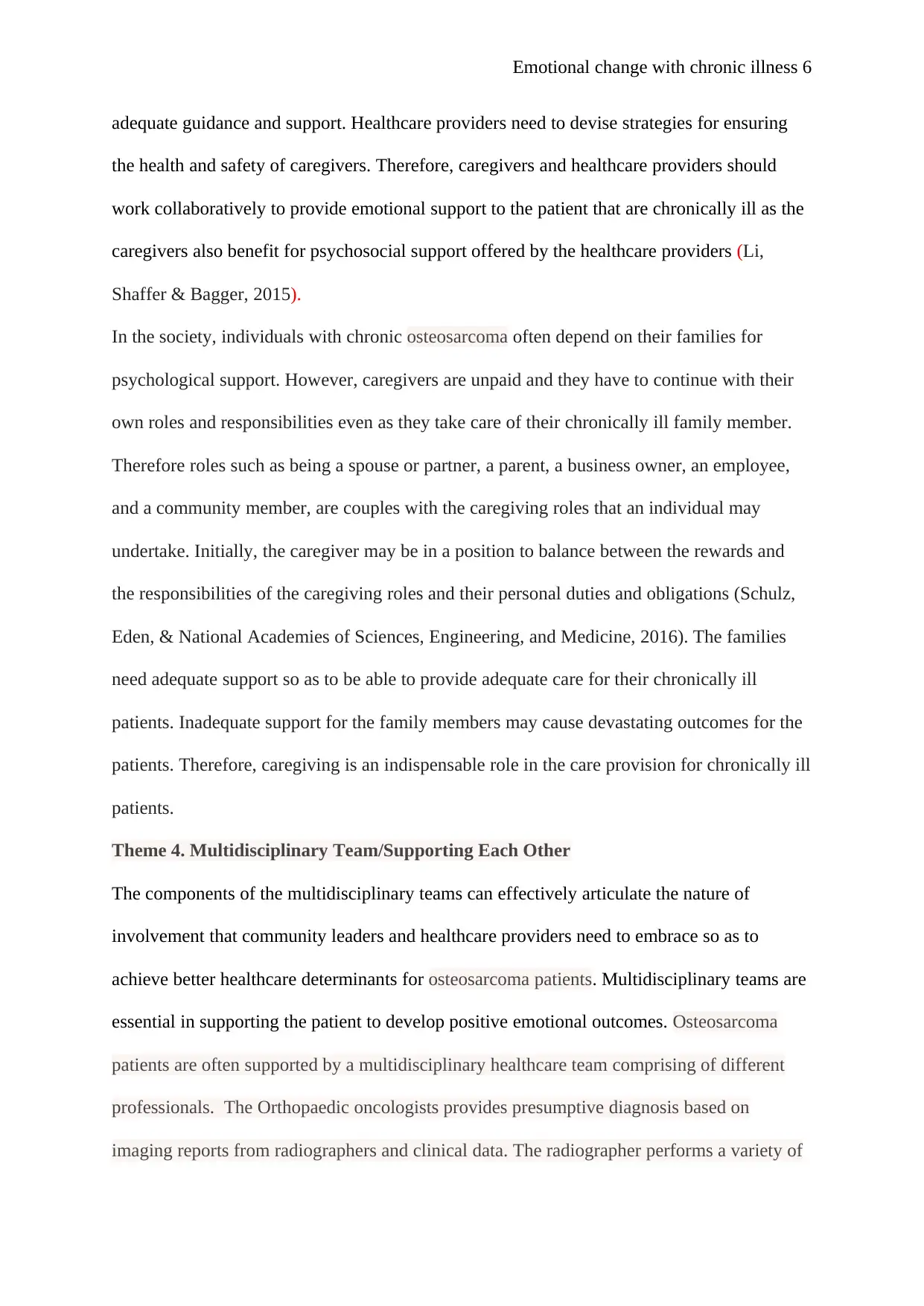
Emotional change with chronic illness 6
adequate guidance and support. Healthcare providers need to devise strategies for ensuring
the health and safety of caregivers. Therefore, caregivers and healthcare providers should
work collaboratively to provide emotional support to the patient that are chronically ill as the
caregivers also benefit for psychosocial support offered by the healthcare providers (Li,
Shaffer & Bagger, 2015).
In the society, individuals with chronic osteosarcoma often depend on their families for
psychological support. However, caregivers are unpaid and they have to continue with their
own roles and responsibilities even as they take care of their chronically ill family member.
Therefore roles such as being a spouse or partner, a parent, a business owner, an employee,
and a community member, are couples with the caregiving roles that an individual may
undertake. Initially, the caregiver may be in a position to balance between the rewards and
the responsibilities of the caregiving roles and their personal duties and obligations (Schulz,
Eden, & National Academies of Sciences, Engineering, and Medicine, 2016). The families
need adequate support so as to be able to provide adequate care for their chronically ill
patients. Inadequate support for the family members may cause devastating outcomes for the
patients. Therefore, caregiving is an indispensable role in the care provision for chronically ill
patients.
Theme 4. Multidisciplinary Team/Supporting Each Other
The components of the multidisciplinary teams can effectively articulate the nature of
involvement that community leaders and healthcare providers need to embrace so as to
achieve better healthcare determinants for osteosarcoma patients. Multidisciplinary teams are
essential in supporting the patient to develop positive emotional outcomes. Osteosarcoma
patients are often supported by a multidisciplinary healthcare team comprising of different
professionals. The Orthopaedic oncologists provides presumptive diagnosis based on
imaging reports from radiographers and clinical data. The radiographer performs a variety of
adequate guidance and support. Healthcare providers need to devise strategies for ensuring
the health and safety of caregivers. Therefore, caregivers and healthcare providers should
work collaboratively to provide emotional support to the patient that are chronically ill as the
caregivers also benefit for psychosocial support offered by the healthcare providers (Li,
Shaffer & Bagger, 2015).
In the society, individuals with chronic osteosarcoma often depend on their families for
psychological support. However, caregivers are unpaid and they have to continue with their
own roles and responsibilities even as they take care of their chronically ill family member.
Therefore roles such as being a spouse or partner, a parent, a business owner, an employee,
and a community member, are couples with the caregiving roles that an individual may
undertake. Initially, the caregiver may be in a position to balance between the rewards and
the responsibilities of the caregiving roles and their personal duties and obligations (Schulz,
Eden, & National Academies of Sciences, Engineering, and Medicine, 2016). The families
need adequate support so as to be able to provide adequate care for their chronically ill
patients. Inadequate support for the family members may cause devastating outcomes for the
patients. Therefore, caregiving is an indispensable role in the care provision for chronically ill
patients.
Theme 4. Multidisciplinary Team/Supporting Each Other
The components of the multidisciplinary teams can effectively articulate the nature of
involvement that community leaders and healthcare providers need to embrace so as to
achieve better healthcare determinants for osteosarcoma patients. Multidisciplinary teams are
essential in supporting the patient to develop positive emotional outcomes. Osteosarcoma
patients are often supported by a multidisciplinary healthcare team comprising of different
professionals. The Orthopaedic oncologists provides presumptive diagnosis based on
imaging reports from radiographers and clinical data. The radiographer performs a variety of
⊘ This is a preview!⊘
Do you want full access?
Subscribe today to unlock all pages.

Trusted by 1+ million students worldwide
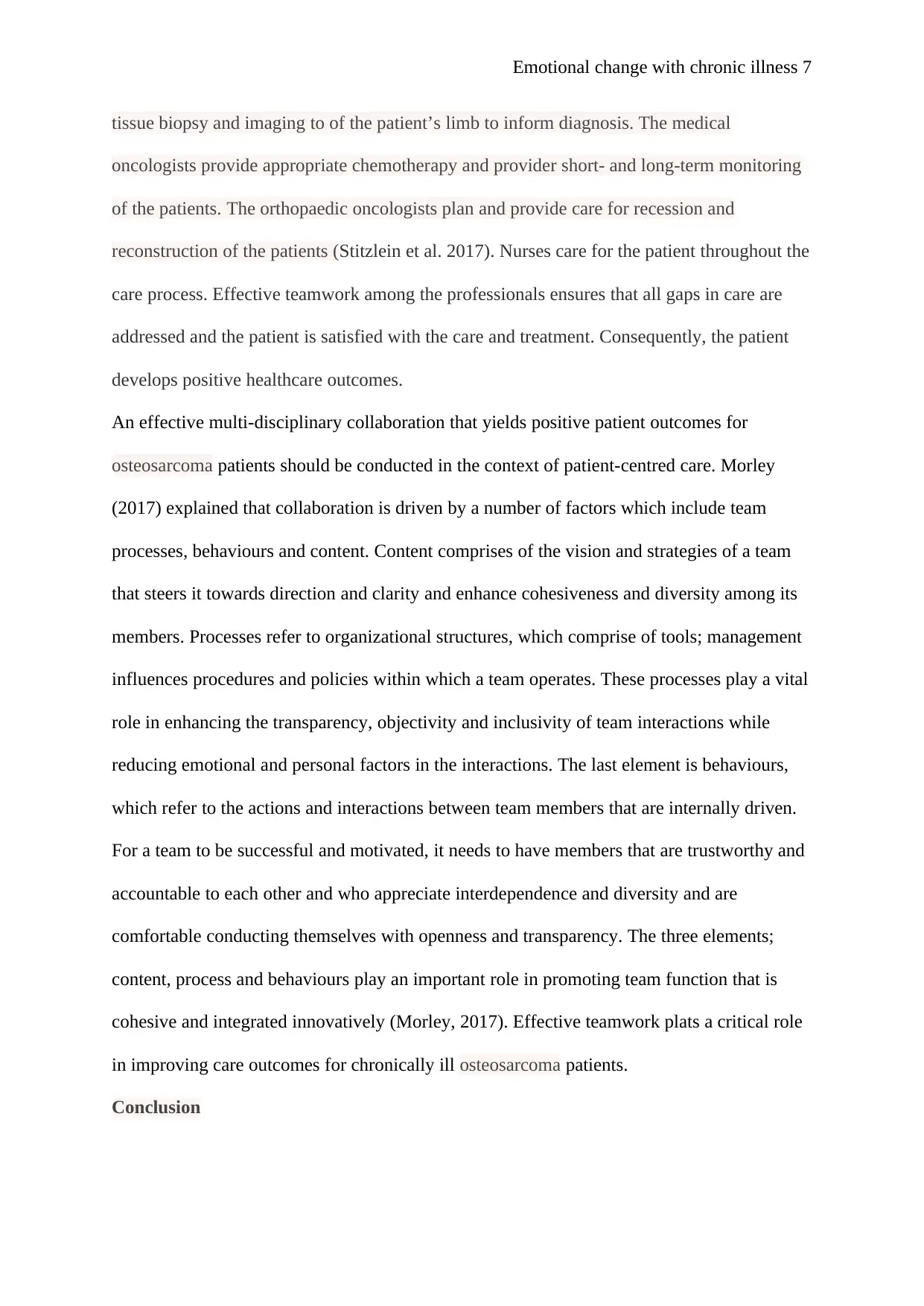
Emotional change with chronic illness 7
tissue biopsy and imaging to of the patient’s limb to inform diagnosis. The medical
oncologists provide appropriate chemotherapy and provider short- and long-term monitoring
of the patients. The orthopaedic oncologists plan and provide care for recession and
reconstruction of the patients (Stitzlein et al. 2017). Nurses care for the patient throughout the
care process. Effective teamwork among the professionals ensures that all gaps in care are
addressed and the patient is satisfied with the care and treatment. Consequently, the patient
develops positive healthcare outcomes.
An effective multi-disciplinary collaboration that yields positive patient outcomes for
osteosarcoma patients should be conducted in the context of patient-centred care. Morley
(2017) explained that collaboration is driven by a number of factors which include team
processes, behaviours and content. Content comprises of the vision and strategies of a team
that steers it towards direction and clarity and enhance cohesiveness and diversity among its
members. Processes refer to organizational structures, which comprise of tools; management
influences procedures and policies within which a team operates. These processes play a vital
role in enhancing the transparency, objectivity and inclusivity of team interactions while
reducing emotional and personal factors in the interactions. The last element is behaviours,
which refer to the actions and interactions between team members that are internally driven.
For a team to be successful and motivated, it needs to have members that are trustworthy and
accountable to each other and who appreciate interdependence and diversity and are
comfortable conducting themselves with openness and transparency. The three elements;
content, process and behaviours play an important role in promoting team function that is
cohesive and integrated innovatively (Morley, 2017). Effective teamwork plats a critical role
in improving care outcomes for chronically ill osteosarcoma patients.
Conclusion
tissue biopsy and imaging to of the patient’s limb to inform diagnosis. The medical
oncologists provide appropriate chemotherapy and provider short- and long-term monitoring
of the patients. The orthopaedic oncologists plan and provide care for recession and
reconstruction of the patients (Stitzlein et al. 2017). Nurses care for the patient throughout the
care process. Effective teamwork among the professionals ensures that all gaps in care are
addressed and the patient is satisfied with the care and treatment. Consequently, the patient
develops positive healthcare outcomes.
An effective multi-disciplinary collaboration that yields positive patient outcomes for
osteosarcoma patients should be conducted in the context of patient-centred care. Morley
(2017) explained that collaboration is driven by a number of factors which include team
processes, behaviours and content. Content comprises of the vision and strategies of a team
that steers it towards direction and clarity and enhance cohesiveness and diversity among its
members. Processes refer to organizational structures, which comprise of tools; management
influences procedures and policies within which a team operates. These processes play a vital
role in enhancing the transparency, objectivity and inclusivity of team interactions while
reducing emotional and personal factors in the interactions. The last element is behaviours,
which refer to the actions and interactions between team members that are internally driven.
For a team to be successful and motivated, it needs to have members that are trustworthy and
accountable to each other and who appreciate interdependence and diversity and are
comfortable conducting themselves with openness and transparency. The three elements;
content, process and behaviours play an important role in promoting team function that is
cohesive and integrated innovatively (Morley, 2017). Effective teamwork plats a critical role
in improving care outcomes for chronically ill osteosarcoma patients.
Conclusion
Paraphrase This Document
Need a fresh take? Get an instant paraphrase of this document with our AI Paraphraser
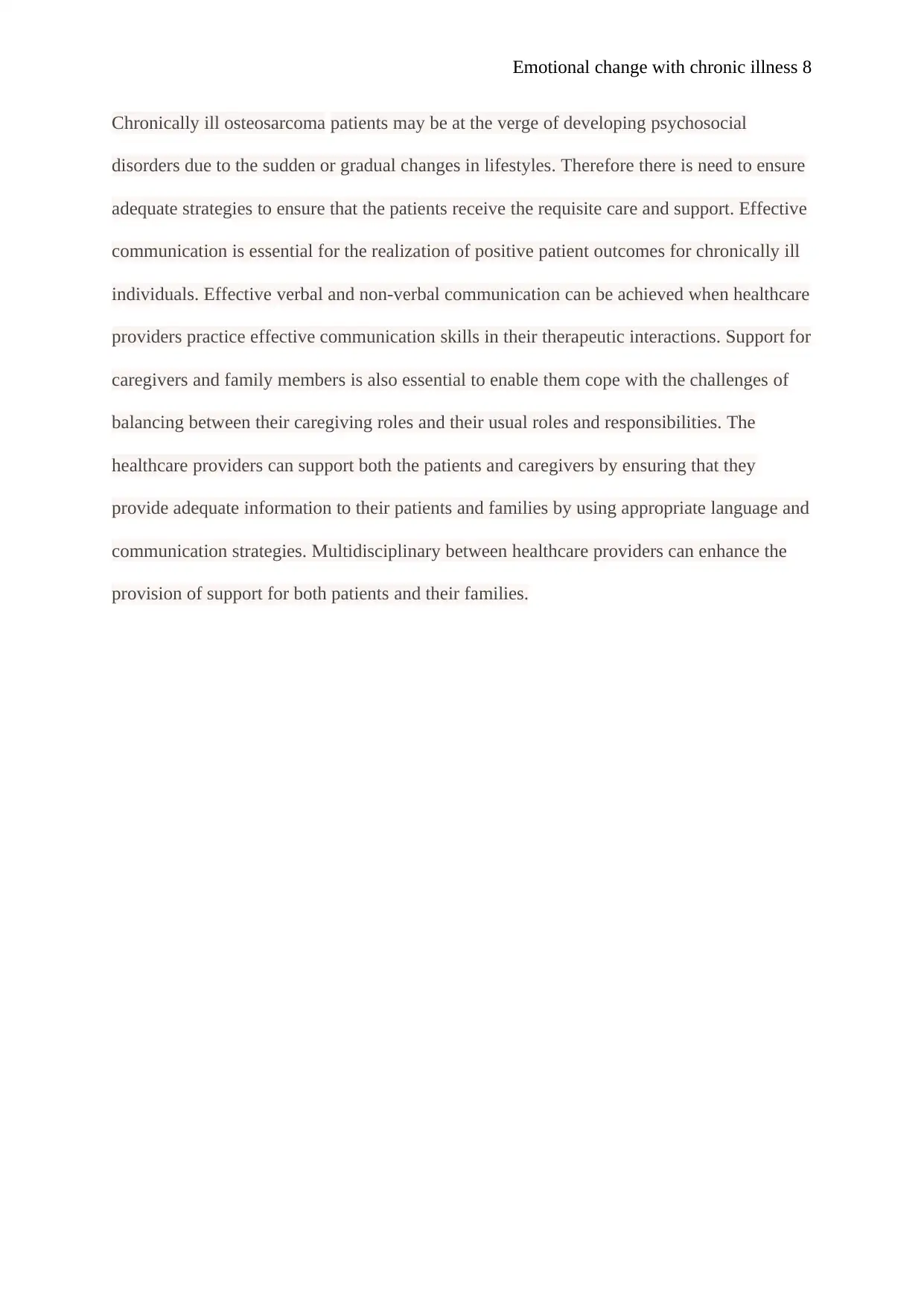
Emotional change with chronic illness 8
Chronically ill osteosarcoma patients may be at the verge of developing psychosocial
disorders due to the sudden or gradual changes in lifestyles. Therefore there is need to ensure
adequate strategies to ensure that the patients receive the requisite care and support. Effective
communication is essential for the realization of positive patient outcomes for chronically ill
individuals. Effective verbal and non-verbal communication can be achieved when healthcare
providers practice effective communication skills in their therapeutic interactions. Support for
caregivers and family members is also essential to enable them cope with the challenges of
balancing between their caregiving roles and their usual roles and responsibilities. The
healthcare providers can support both the patients and caregivers by ensuring that they
provide adequate information to their patients and families by using appropriate language and
communication strategies. Multidisciplinary between healthcare providers can enhance the
provision of support for both patients and their families.
Chronically ill osteosarcoma patients may be at the verge of developing psychosocial
disorders due to the sudden or gradual changes in lifestyles. Therefore there is need to ensure
adequate strategies to ensure that the patients receive the requisite care and support. Effective
communication is essential for the realization of positive patient outcomes for chronically ill
individuals. Effective verbal and non-verbal communication can be achieved when healthcare
providers practice effective communication skills in their therapeutic interactions. Support for
caregivers and family members is also essential to enable them cope with the challenges of
balancing between their caregiving roles and their usual roles and responsibilities. The
healthcare providers can support both the patients and caregivers by ensuring that they
provide adequate information to their patients and families by using appropriate language and
communication strategies. Multidisciplinary between healthcare providers can enhance the
provision of support for both patients and their families.
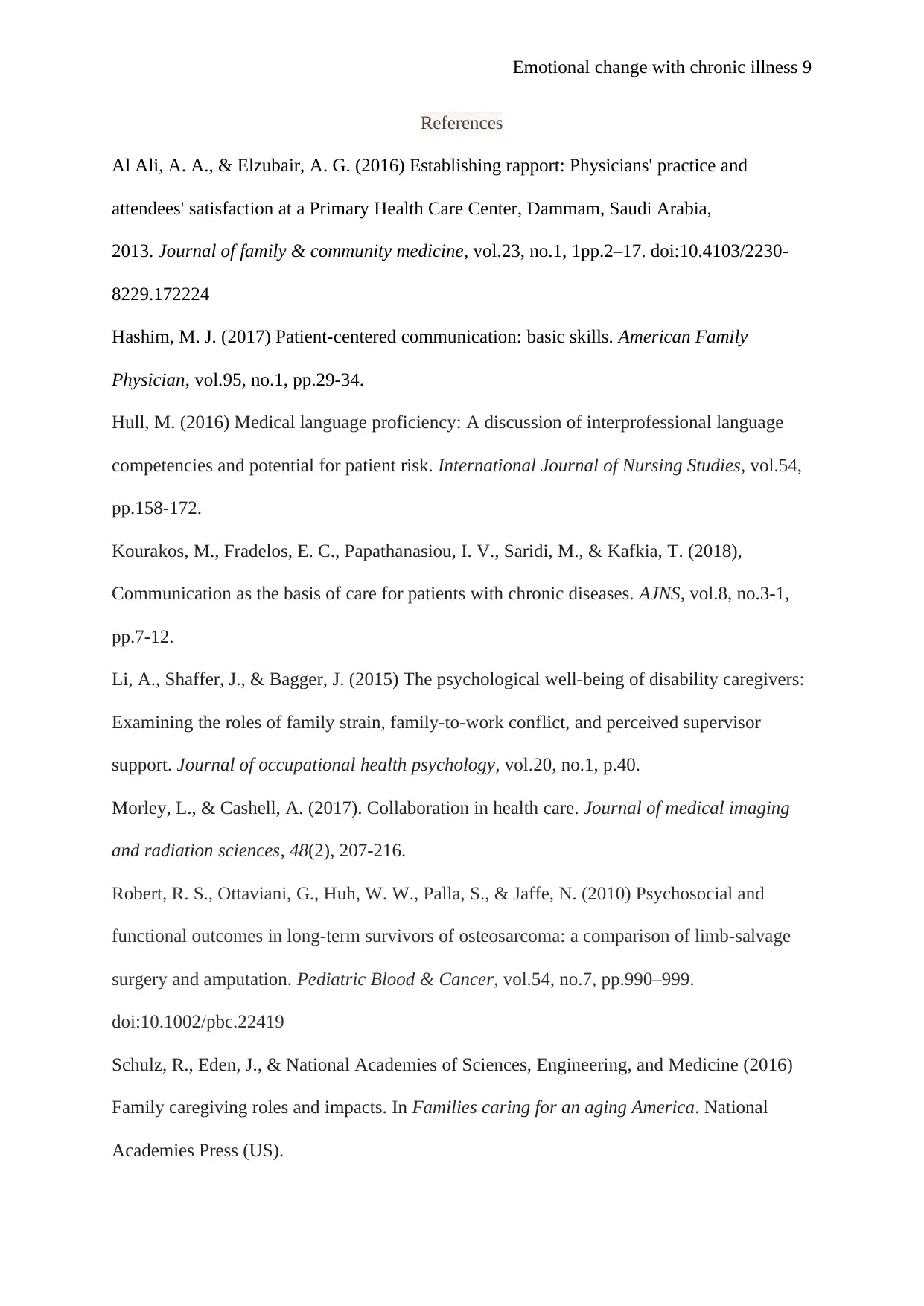
Emotional change with chronic illness 9
References
Al Ali, A. A., & Elzubair, A. G. (2016) Establishing rapport: Physicians' practice and
attendees' satisfaction at a Primary Health Care Center, Dammam, Saudi Arabia,
2013. Journal of family & community medicine, vol.23, no.1, 1pp.2–17. doi:10.4103/2230-
8229.172224
Hashim, M. J. (2017) Patient-centered communication: basic skills. American Family
Physician, vol.95, no.1, pp.29-34.
Hull, M. (2016) Medical language proficiency: A discussion of interprofessional language
competencies and potential for patient risk. International Journal of Nursing Studies, vol.54,
pp.158-172.
Kourakos, M., Fradelos, E. C., Papathanasiou, I. V., Saridi, M., & Kafkia, T. (2018),
Communication as the basis of care for patients with chronic diseases. AJNS, vol.8, no.3-1,
pp.7-12.
Li, A., Shaffer, J., & Bagger, J. (2015) The psychological well-being of disability caregivers:
Examining the roles of family strain, family-to-work conflict, and perceived supervisor
support. Journal of occupational health psychology, vol.20, no.1, p.40.
Morley, L., & Cashell, A. (2017). Collaboration in health care. Journal of medical imaging
and radiation sciences, 48(2), 207-216.
Robert, R. S., Ottaviani, G., Huh, W. W., Palla, S., & Jaffe, N. (2010) Psychosocial and
functional outcomes in long-term survivors of osteosarcoma: a comparison of limb-salvage
surgery and amputation. Pediatric Blood & Cancer, vol.54, no.7, pp.990–999.
doi:10.1002/pbc.22419
Schulz, R., Eden, J., & National Academies of Sciences, Engineering, and Medicine (2016)
Family caregiving roles and impacts. In Families caring for an aging America. National
Academies Press (US).
References
Al Ali, A. A., & Elzubair, A. G. (2016) Establishing rapport: Physicians' practice and
attendees' satisfaction at a Primary Health Care Center, Dammam, Saudi Arabia,
2013. Journal of family & community medicine, vol.23, no.1, 1pp.2–17. doi:10.4103/2230-
8229.172224
Hashim, M. J. (2017) Patient-centered communication: basic skills. American Family
Physician, vol.95, no.1, pp.29-34.
Hull, M. (2016) Medical language proficiency: A discussion of interprofessional language
competencies and potential for patient risk. International Journal of Nursing Studies, vol.54,
pp.158-172.
Kourakos, M., Fradelos, E. C., Papathanasiou, I. V., Saridi, M., & Kafkia, T. (2018),
Communication as the basis of care for patients with chronic diseases. AJNS, vol.8, no.3-1,
pp.7-12.
Li, A., Shaffer, J., & Bagger, J. (2015) The psychological well-being of disability caregivers:
Examining the roles of family strain, family-to-work conflict, and perceived supervisor
support. Journal of occupational health psychology, vol.20, no.1, p.40.
Morley, L., & Cashell, A. (2017). Collaboration in health care. Journal of medical imaging
and radiation sciences, 48(2), 207-216.
Robert, R. S., Ottaviani, G., Huh, W. W., Palla, S., & Jaffe, N. (2010) Psychosocial and
functional outcomes in long-term survivors of osteosarcoma: a comparison of limb-salvage
surgery and amputation. Pediatric Blood & Cancer, vol.54, no.7, pp.990–999.
doi:10.1002/pbc.22419
Schulz, R., Eden, J., & National Academies of Sciences, Engineering, and Medicine (2016)
Family caregiving roles and impacts. In Families caring for an aging America. National
Academies Press (US).
⊘ This is a preview!⊘
Do you want full access?
Subscribe today to unlock all pages.

Trusted by 1+ million students worldwide
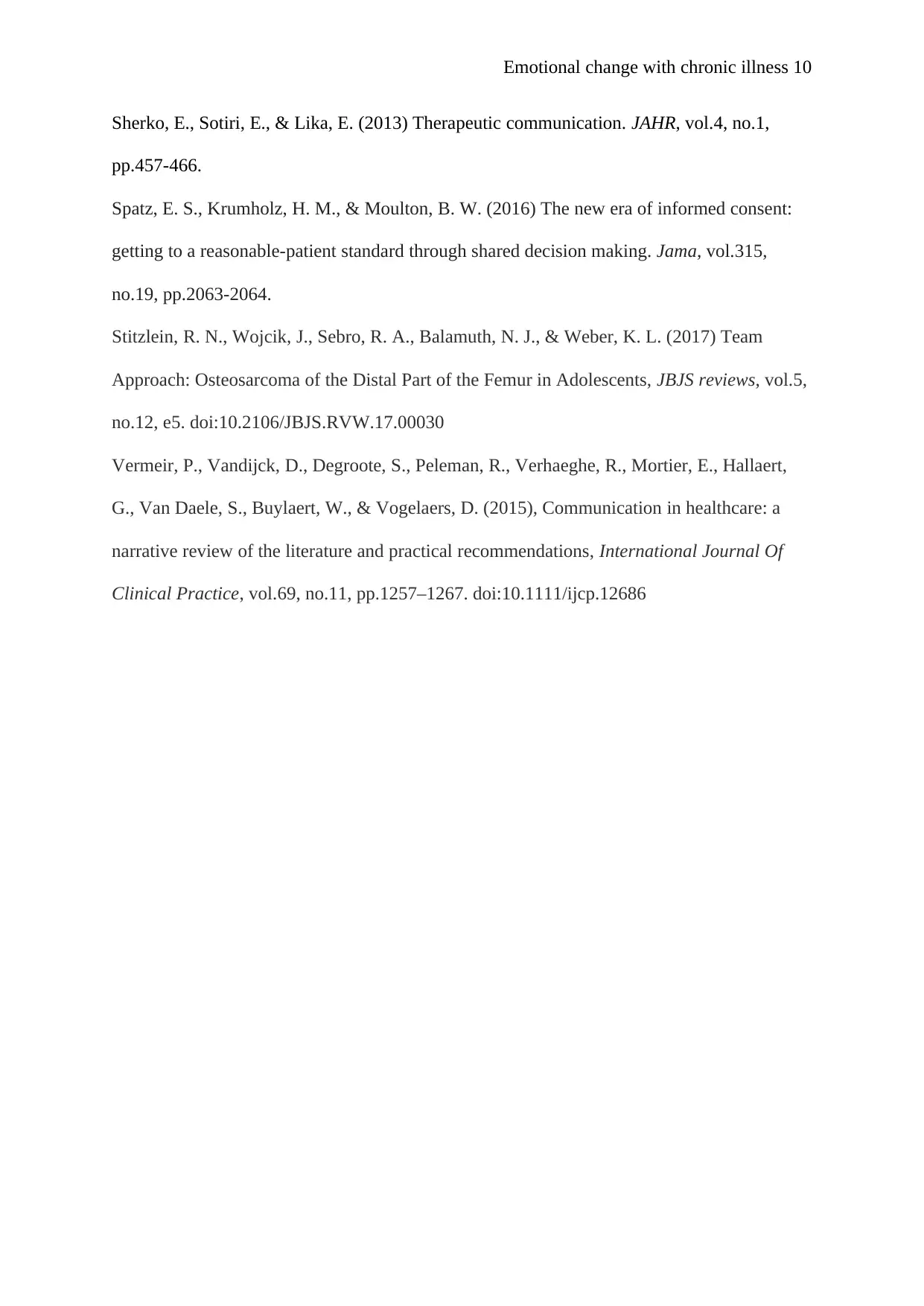
Emotional change with chronic illness 10
Sherko, E., Sotiri, E., & Lika, E. (2013) Therapeutic communication. JAHR, vol.4, no.1,
pp.457-466.
Spatz, E. S., Krumholz, H. M., & Moulton, B. W. (2016) The new era of informed consent:
getting to a reasonable-patient standard through shared decision making. Jama, vol.315,
no.19, pp.2063-2064.
Stitzlein, R. N., Wojcik, J., Sebro, R. A., Balamuth, N. J., & Weber, K. L. (2017) Team
Approach: Osteosarcoma of the Distal Part of the Femur in Adolescents, JBJS reviews, vol.5,
no.12, e5. doi:10.2106/JBJS.RVW.17.00030
Vermeir, P., Vandijck, D., Degroote, S., Peleman, R., Verhaeghe, R., Mortier, E., Hallaert,
G., Van Daele, S., Buylaert, W., & Vogelaers, D. (2015), Communication in healthcare: a
narrative review of the literature and practical recommendations, International Journal Of
Clinical Practice, vol.69, no.11, pp.1257–1267. doi:10.1111/ijcp.12686
Sherko, E., Sotiri, E., & Lika, E. (2013) Therapeutic communication. JAHR, vol.4, no.1,
pp.457-466.
Spatz, E. S., Krumholz, H. M., & Moulton, B. W. (2016) The new era of informed consent:
getting to a reasonable-patient standard through shared decision making. Jama, vol.315,
no.19, pp.2063-2064.
Stitzlein, R. N., Wojcik, J., Sebro, R. A., Balamuth, N. J., & Weber, K. L. (2017) Team
Approach: Osteosarcoma of the Distal Part of the Femur in Adolescents, JBJS reviews, vol.5,
no.12, e5. doi:10.2106/JBJS.RVW.17.00030
Vermeir, P., Vandijck, D., Degroote, S., Peleman, R., Verhaeghe, R., Mortier, E., Hallaert,
G., Van Daele, S., Buylaert, W., & Vogelaers, D. (2015), Communication in healthcare: a
narrative review of the literature and practical recommendations, International Journal Of
Clinical Practice, vol.69, no.11, pp.1257–1267. doi:10.1111/ijcp.12686
1 out of 10
Related Documents
Your All-in-One AI-Powered Toolkit for Academic Success.
+13062052269
info@desklib.com
Available 24*7 on WhatsApp / Email
![[object Object]](/_next/static/media/star-bottom.7253800d.svg)
Unlock your academic potential
Copyright © 2020–2025 A2Z Services. All Rights Reserved. Developed and managed by ZUCOL.





